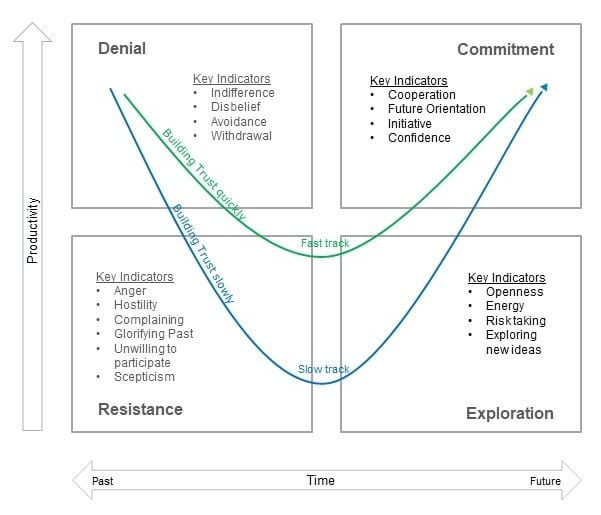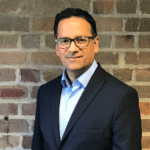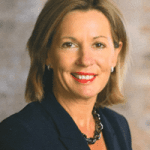3 steps directors can take to restore trust
The Art of Leadership
Newsletter
Day after day, the Banking Royal Commission seems to be chipping away at the edifice of trust on which some of Australia’s largest institutions are built. In our May newsletter we addressed the subject of how leaders can start to rebuild organisational trust. In response to that blog, the Australian Institute of Company Directors (AICD) asked us to expand on the subject for their August edition of Company Director, which is focused entirely on the topic of trust.
In this newsletter, we’re delighted to share the article with you.
We are also excited to share that our Queensland Associate Team is expanding. We welcome Elizabeth Hughes to the team and encourage you to view her profile below.
Regards,
Virginia Mansell
Founding Partner
3 steps directors can take to restore trust

There are practical steps boards and management can take to restore trust, but they must be ready for the journey.
In our heads, the alarm bells were ringing. As we sat around the table with the behavioural assessment results of the top 40 people at a big financial institution, we could see telltale danger signs which, if left unaddressed, could be explosive for the company.A change of strategy from a new CEO had tilted the culture away from a previously healthy balance of results and customer service. The weight had now shifted dramatically to hitting financial targets — at the expense of doing the right thing. It was a disaster waiting to happen.
We needed to feed these results back to the leadership and board, and work with the executives to highlight the implications of their results. The head of human resources said there wasn’t a budget. The CFO said “people stuff” was HR’s business. The chair changed the subject. The board director told us they would get on to culture when everything else had been sorted.
Turn the clock forward two years and the same institution has been giving evidence at the Royal Commission into Misconduct in the Banking, Superannuation and Financial Services Industry — and just as damagingly, in the court of public opinion.
Boards have not been immune to the pain. Many in the banking and financial services industry have found themselves in the firing line for the poor governance and for accepting cultures that have seen the public lose their faith and trust in them. So what next? What concrete steps should boards be taking to learn from the sins of the past?
Psychology of change
Critical to the success of any change process is an understanding of the psychology of change.
The Swiss-American psychiatrist Elisabeth Kübler-Ross describes the process of change as the stages of a “curve”. It starts with denial, resistance and exploration, ending with commitment. Some people will journey through these stages rapidly, while others — such as the key stakeholders at the financial institution we were describing earlier — find it difficult to move through the initial stages of denial and resistance.

The upshot is that any attempt to change a culture and rebuild organisational trust must follow the arc of the change curve. Historical precedent shows how it can be done.
1. Address denial by engendering transparency
Denial is hard to address if you can’t see it. Boards therefore need to engender transparency at all levels. Entertainment company Netflix, for example, encourages transparency between the CEO, executives and the board in two ways. First, board members periodically sit in on monthly and quarterly senior management meetings, in a listening capacity only.
Secondly, it dictates board communications should be structured as 30-page online memos that include links to supporting analysis and also allow access to all data and information that sit on the company’s internal shared systems. They can also ask questions of the authors.
Netflix founder and CEO Reed Hastings says these practices help the board provide “an extreme duty of care” to the corporation. “The board isn’t going to have the confidence to make hard decisions unless they really understand the market and the company,” he says. Australian software company Atlassian enshrines transparency in its unambiguous corporate value of “Open company, no bullshit”. In fact, the company credits its transparency for much of its achievement. Atlassian is an Australian success story in terms of revenue and growth, and is consistently in the top five of the best places to work in Australia — all of which Atlassian says are a downstream effect of a high-performance culture.
2. Move through resistance and exploration by promoting candour
It can be difficult to get people to tell you what you don’t want to hear. For teams to feel the psychological safety required, a standard for honest and open conversations needs to be set at the top, by the board.
Alan Mulally, former CEO of Ford, used the common traffic light system in management meetings — a green light meant all was well, orange meant something needed attention and red meant something was critical.
At his first four meetings, he was “awash” with green. He confronted his team, “We are going to lose $18 billion this year, so is there anything that’s not going well?” The following meeting, when one of his executives flagged a problem, Mulally congratulated him and asked what the group could do to help out.
Boards can also welcome the bearers of bad news and encourage speaking out, providing protection for whistleblowing and making sure the organisation sees that action is taken as a result of candour. They can also build a trusting and open relationship with the executive team, encouraging discussion, rather than reporting.
An example of how a change in tone from the board can elicit a shift in culture comes from an Australian logistics company we worked with several years ago. When it saw the number of lost-time injuries increase, the board instructed the CEO to reverse the trend. Through cascading the instruction, he accomplished the desired decline in reported injuries. However, it soon became clear that it was only the reporting of lost-time injuries that declined.
By creating a draconian environment where management was hauled over the coals for reported lost-time injuries, the CEO had unwittingly introduced measures encouraging management to game the system. Lost-time injuries were concealed, but crucially, so were near misses and accidents not resulting in lost time, both vital safety metrics.
Things only changed when the board shifted from an inquisitorial tone to an exploratory one, asking questions such as, “What can we learn from near misses?”
When people (including the CEO) felt safe to report accidents and near misses without the fear of retribution, reports initially spiked, but over a period of time, incidents sharply declined.
Businessman and board member David Gonski AC FAICDLife calls this disarming ability to explore, connect and build trust “becoming human”. He advocates running board meetings with the CEO reporting extempore on the issues of the day. He also recommends bringing in the next layer of management to test assumptions and perceptions.
3. Develop commitment with leaders who look in the mirror. Set metrics that motivate
Just because an organisation has buy-in to new values-led behaviours, doesn’t necessarily mean these behaviours are going to stick. Kübler-Ross highlights the fact that, unchecked, individuals can regress along the behavioural change curve.
A board can take the lead with this by raising its visibility within an organisation and promote “a clear tone at the top in both messaging and action,” as recently recommended by the Australian Prudential Regulation Authority (APRA). Nonetheless, boards must still rely on the executive to authentically close the gap between the “talk” and the “walk”.
APRA’s recommendations in this regard include that senior leaders reinforce key behaviours such as, “self-reflection, giving and receiving constructive feedback… and cascading the desired tone at the top in a personal and authentic manner.”
The tone at the top needs to echo back from the whole organisation and that means that leaders need to consistently and unfailingly demonstrate the behaviours that define the culture norms. Without that congruence, it becomes impossible to build and sustain trust in the entirety of the organisation.
To make this work, boards need to elevate the importance of competencies such as emotional intelligence by recruiting for them and measuring, tracking and developing them. Of course, that’s not all that needs to be measured. To sustain authentic, self-reflective behaviours, boards also need to take a critical look at incentive structures, watching for unintended consequences that encourage undesirable or unethical behaviours.
The first step in this process is defining ethical leadership — a concept that seems to be under assault by a global counterculture. It’s hard to be selfless, defy groupthink and be ferociously customer-focused if you’re under the blowtorch of short-term profits.
In fact, APRA chair Wayne Byres has gone so far as to recommended rebalancing CEO bonuses away from the generation of short-term profits to rewarding them for good risk management and customer outcomes.
There are no silver bullets here. No magic injections. As with any relationship built on trust, organisational trust is built incrementally, through a relentless and sustained approach and, crucially, with executive sponsorship and direct involvement from the very top.
Kind Regards,
Virginia Mansell & Mehul Joshi
About the Authors:
 Mehul Joshi is a Partner with the Stephenson Mansell Group, a former award-winning broadcast journalist for the BBC, and an experienced executive. As a leadership consultant and executive coach, he has implemented successful interventions for some of the world’s biggest companies in the United States, Europe, Asia, and Australia.
Mehul Joshi is a Partner with the Stephenson Mansell Group, a former award-winning broadcast journalist for the BBC, and an experienced executive. As a leadership consultant and executive coach, he has implemented successful interventions for some of the world’s biggest companies in the United States, Europe, Asia, and Australia.

Virginia Mansell is Founding Partner of Stephenson Mansell Group, arguably Australia’s longest-established executive development firm. Virginia is an author, expert and thought leader in executive coaching, mentoring and leadership.
In addition to her own experience as a business leader, Virginia brings to her role more than 30 years in human resource management, counselling psychology, psychotherapy and organisational consulting and executive coaching.
What’s on
 Are you ready to launch your leadership career?
Are you ready to launch your leadership career?
Designed to help female senior leaders to align who they are with how they lead, the Perspectives on Leadership for Women program has a practical and hands-on approach and focuses on personal presence and communication; resilience; change and complexity; and finding your mentors and sponsors.
Melbourne – Perspectives on Leadership for Women – 5 September & 10 October 2018
Sydney – Perspectives on Leadership for Women – 19 October & 16 November 2018
Brisbane – Perspectives on Leadership for Women – 26 October & 30 November
 Executive Presence and Impact Workshop with Peter Kingston, Specialist Communications Coach
Executive Presence and Impact Workshop with Peter Kingston, Specialist Communications Coach
Sought after and continually sold out, don’t leave your registration to the last minute!
Make the most of this opportunity to experience an immediate impact on your presence; deliver your messages with improved confidence and clarity; understand how to quickly connect with audiences; and learn the secret to speaking less and saying more.
“Peter was engaging, full of energy and came from a different viewpoint which added value“.
Sydney, 7th November 2018
This month at SMG

Our Queensland Team is expanding.
We are delighted to announce the appointment of Elizabeth Hughes to our team in Queensland as an Executive Coach and Facilitator
Elizabeth joins SMG with 25 years of business experience and extensive knowledge in organisational development, leadership and mindfulness. Elizabeth has worked with Boards, CEOs and their executive teams across resources, construction, retail, professional and financial services, health, education and the public sector.
Elizabeth has a great passion for supporting all leaders – especially women in leadership roles – to develop their leadership style, navigate their career, and operate successfully with confidence and impact.
We are excited to have Elizabeth join us in Queensland adding to our expert team of professional executive coaches and facilitators.
What’s Trending in Leadership?
 Communication is the foundation for trust in any relationship. Here, Art Petty details the ways leaders build trust in teams.
Communication is the foundation for trust in any relationship. Here, Art Petty details the ways leaders build trust in teams.
So, whose responsibility is it to establish and foster trust in an organisation anyway? Surely, it is everyone’s obligation to be on board with the concept, but which business unit is best to have their hands on the steering wheel?
Discover how Disney defines its corporate culture by the actions of its leaders.
Meet our Team
 This month in ‘Meet our Team’ … Meet Andrew Wynne
This month in ‘Meet our Team’ … Meet Andrew Wynne
How did you first became involved in the coaching space?
I’ve always been deeply curious about what it is to be human. I initially studied Mechanical Engineering, and worked in that field for several years. Later, it was the excitement of IT that lured me, and for a time, I was fortunate enough to be able to blend both passions together. But whilst the science and precision of engineering, and the structure and process of IT held appeal, nothing was quite as alluring as the subtle complexity that any of these disciplines took on when you added a handful of human beings.
I studied Psychology via correspondence for two years in the late 1990s, but on its own it was pretty dry. But in late 2008, as my management consulting practice really started to take shape, I started to read more and more about the maturing field of coaching. After a long and sometimes frustrating search through many less than credible organisations, I eventually committed to study Integral Coaching. The method seemed to beautifully attend to the individuality of the person in focus, as well as the social context in which he or she was embedded. It included their thoughts, beliefs, emotions, and intentions, as well as everything that was happening to them physiologically. This method effortlessly closed the gap between people and process, and my journey to coaching had begun.
What has surprised you most about working as a coach?
This is a great question… I could almost write a book on this topic. The trust my clients invest in me is always something that humbles me. But perhaps the greatest surprise I have had has been how sometimes it’s the smallest change in a coach’s behaviour, belief or way of being, can have the biggest impact. I can’t talk for anyone but myself, but I remember in my early days, I was pretty fixated on completely blowing my coachees away! Some good supervision set me straight. But it’s something I have heard a number of other coaches discussing, and so I guess I am not alone here.
Is there any advice you would give to someone who is progressing their career towards a key leadership role?
1. Seek constructive, grounded feedback. Understanding what you do really well, or what you aren’t doing at all, gives you enormous perspective. Then create a solid plan for how you are going to grow, and who you can enrol to support you.
2. Develop your self-awareness. Be still, and listen to your heart. Shining a light on your underlying thought patterns brings understanding of what might drive current behaviour, which in turn brings access to new choices and possibilities.
3. Learn to empower others. “For the great achiever, it’s all about me. For the great leader, it’s all about them”.
As you know we are always growing and learning. Is there any one thing you would like to take the time to learn more about?
I am really excited about working with teams, and in particular, systemic team coaching. Systemic team coaching is a process by which a team coach works in partnership with a team, in order to help them improve how they work together, along with their collective performance.
Working with both the individuals of the group, and the group of individuals, brings a complexity to the coaching that can be amazingly rewarding, challenging and exciting.
What are some of your passions outside of the office?
There are a number of things I love to do that help me to “get out of my head” which is where I find working as a coach tends to take me. Exercise does this for me, so I often take off on long runs, or long swims.
I still really love to work with my hands. It’s possibly a link back to a younger, more creative version of myself, and is probably linked to the phase of my engineering working life when I was involved in research and design. This means I am often found in my shed, covered in saw dust as I create something out of wood, or with welding goggles on, as I attempt to create a new piece. Photography is another creative outlet. As is cooking, and pairing wines I have discovered, with whatever it is I am cooking. And then finally, there is mindfulness. I practise this daily, either sitting quietly in the traditional fashion, or more recently, by combining mindfulness whilst doing one of the things I mentioned above, such as woodwork, or cooking.
Where will we find you on your days off?
What’s a day off? When I am not working, you might find me on the side of a sports field, screaming for Alex my 14 year-old son. Or back in the shed building something with Matthew, my 16 year-old son (at the moment we are building a new aquaponics system he has been researching online). And no weekend is ever complete unless it involves some time sitting with some of the many friends we are so blessed to have, enjoying good food, wine and conversation.








